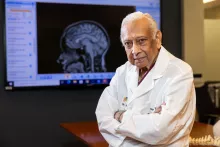Craniosynostosis
- For all other requests:
- 1-888-573-5437
Craniosynostosis occurs when some of the bones that make up your baby’s skull fuse together at the seams (sutures) too quickly. This prevents parts of the skull from expanding. As your child’s brain grows, the head or face may become misshapen.
Because treatment usually requires surgery—often during the first year of life—you should carefully consider where to seek care.
University of Iowa Health Care is home to some of the country’s leading craniosynostosis experts. Our pediatric neurosurgeons diagnose and treat all types of this condition, including single-suture, multiple suture, and inherited (syndromic) craniosynostosis. We also offer every kind of surgical treatment, for children including cranial vault reconstruction and endoscopic strip craniectomy.
Our goal is to diagnose and treat your child as early as possible, reducing their risk of long-term cognitive or cosmetic problems.
Craniosynostosis types and symptoms
If your baby is born with craniosynostosis, their skull abnormality may be visible at birth. Or you may begin to see signs of craniosynostosis in the first few weeks or months of life—a period of rapid brain growth.
Types of craniosynostosis
Our team has experience treating all types of this condition, including:
- Single-suture (primary) craniosynostosis: ut of the four major sutures in the skull, only one fuses. These types—coronal, lambdoid, metopic, and sagittal craniosynostosis—are named for the suture that closes.
- Multiple suture craniosynostosis: Two or more sutures in the skull fuse together.
- Syndromic craniosynostosis: A genetic disorder, such as Apert syndrome or Crouzon syndrome, causes the skull bones to fuse too early.
Signs of craniosynostosis include:
- An unusually shaped skull. Face and head irregularities depend on the suture(s) impacted. For example, with sagittal craniosynostosis the head will be long and narrow. With coronal craniosynostosis, the head will look short and wide, and an eye socket may be out of alignment.
- A hard, raised ridge you can feel through the scalp.
- A missing or bulging “soft spot” (fontanel).
- A noticeably small head (your baby’s head doesn’t seem to grow in proportion with the rest of their body).
In severe cases, as when several sutures fuse, too much pressure may build up inside the skull as the brain tries to grow. This can cause more serious symptoms, including:
- Developmental delays
- Eye problems, including trouble seeing or moving the eyes
- Low energy or drowsiness
- Seizures
- Vomiting
Diagnosing craniosynostosis
At UI Health Care, we have the tools it takes to diagnose craniosynostosis and any related medical problems.
For example, we use advanced imaging tests (such as CT or MRI) to rule out other factors that can cause a flat or misshapen head. These include childbirth and sleeping positions. Imaging tests also help us confirm which parts of the skull are impacted.
And, because we’re home to the only pediatric genetics program of its kind in Iowa, we can confirm whether your child’s craniosynostosis is caused by a gene mutation. This helps us understand whether your child is likely to have other medical problems that also need treatment.
Craniosynostosis surgery from UI Health Care
Although very mild cases of craniosynostosis may not need treatment, most children with this condition need surgery.
The type of surgery your child should have depends on several factors, including:
- The type of surgery your child should have depends on several factors, including:
- Their age
- How many sutures are fused
- Where the sutures are located
No matter which procedure your child has, our goals are the same: to correct the shape of their skull and make sure their brain has enough room to grow.
Endoscopic craniosynostosis surgery
During a procedure called endoscopic strip craniectomy, we can repair fused sutures with only a few small incisions in the scalp. Steps include:
- Your child’s surgeon will access the skull using a hollow, flexible tube (endoscope) fitted with a light, camera, and tiny surgical instruments.
- Next, they’ll cut out the fused suture, and then remove two small strips of bone near your child’s ears.
- After cutting these strips into pieces, the surgeon will sew the pieces back into each area where bone was removed. Over time, all these pieces will knit together with the surrounding bone, so there are no gaps in the skull.
Your baby will probably need to wear a special helmet for several months after endoscopic surgery. This helmet will also help the skull achieve a natural shape as it grows.
When we use endoscopic surgery
Endoscopic surgery is reserved for babies who meet certain criteria, including:
- Age. We usually perform endoscopic strip craniectomy within the first four months of life. That’s because the brain grows a lot during this period. Once the fused suture is removed, the skull can naturally reshape itself to fit the rapidly expanding brain.
- Number of sutures. In most cases, we use the endoscopic approach to treat single-suture craniosynostosis.
Open craniosynostosis surgery
In many cases, an open surgical procedure called cranial vault reconstruction is the most effective treatment option. Steps include:
- Your child’s surgeon will remove pieces of skull that are next to any fused sutures.
- Next, they’ll use special tools to reshape those skull pieces, and then reattach them to the skull.
- Finally, they’ll insert dissolvable plates or stitches. These will help hold all the pieces in place until the skull bones knit back together.
Some babies, especially those with genetic syndromes, may need additional surgery later in life. That’s because premature fusions caused by a gene mutation can happen again. And some genetic conditions cause other head and face abnormalities that also need correction.
When we use open surgery
Cranial vault reconstruction is an option for many patients, including:
- Children of any age—including newborns—who have several fused sutures.
- Children older than 4 months old, no matter what type of craniosynostosis they have.
- Children who need multiple corrections at the same time. For example, if we need to reshape the back of the skull along with an eye socket, we can do this in a single procedure.
A team approach
When you choose UI Health Care, your child will receive care from a team of experts in multiple specialties. Each team member has the skill and experience it takes to treat even the most rare or severe types of craniosynostosis.
Your child’s neurosurgeon may partner with one or more of the following pediatric specialists:
Genetic counselor who will teach you about the genetic testing process and help you understand your child’s test results
Ophthalmologist who can assess and treat problems with the eye muscle or eye growth
Otolaryngologist who helps operate on delicate areas inside the head and neck
Plastic and reconstructive surgeon who can correct facial abnormalities
Craniosynostosis that is severe (or caused by a genetic disorder) can cause problems with thinking and learning. If your child needs help reaching a developmental milestones, we also offer pediatric psychology, rehabilitation, and other support services.
Our Care Team
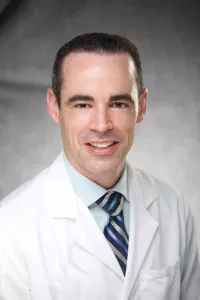
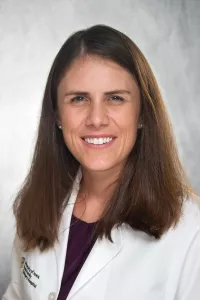
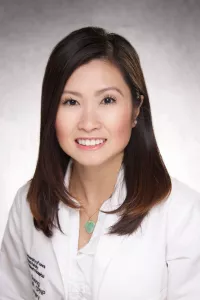
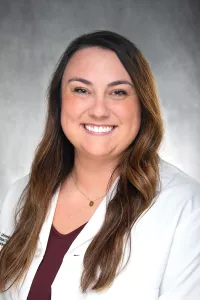
Need help finding a craniosynostosis surgeon?
Locations and Offices

Related Health Topics
Related News
